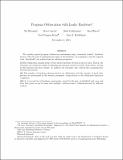Program Obfuscation with Leaky Hardware
Author(s)
Bitansky, Nir; Canetti, Ran; Goldwasser, Shafi; Halevi, Shai; Kalai, Yael Tauman; Rothblum, Guy N.; ... Show more Show less
DownloadGoldwasser_Program obfuscation.pdf (579.4Kb)
OPEN_ACCESS_POLICY
Open Access Policy
Creative Commons Attribution-Noncommercial-Share Alike
Terms of use
Metadata
Show full item recordAbstract
We consider general program obfuscation mechanisms using “somewhat trusted” hardware devices, with the goal of minimizing the usage of the hardware, its complexity, and the required trust. Specifically, our solution has the following properties:
(i) The obfuscation remains secure even if all the hardware devices in use are leaky. That is, the adversary can obtain the result of evaluating any function on the local state of the device, as long as this function has short output. In addition the adversary also controls the communication between the devices.
(ii) The number of hardware devices used in an obfuscation and the amount of work they perform are polynomial in the security parameter independently of the obfuscated function’s complexity.
(iii) A (universal) set of hardware components, owned by the user, is initialized only once and from that point on can be used with multiple “software-based” obfuscations sent by different vendors.
Date issued
2011Department
Massachusetts Institute of Technology. Department of Electrical Engineering and Computer ScienceJournal
Advances in Cryptology – ASIACRYPT 2011
Publisher
Springer-Verlag Berlin Heidelberg
Citation
Bitansky, Nir, Ran Canetti, Shafi Goldwasser, Shai Halevi, Yael Tauman Kalai, and Guy N. Rothblum. “Program Obfuscation with Leaky Hardware.” Advances in Cryptology – ASIACRYPT 2011 (Lecture Notes in Computer Science; volume 7073) (2011): 722–739.
Version: Author's final manuscript
ISBN
978-3-642-25384-3
978-3-642-25385-0
ISSN
0302-9743
1611-3349